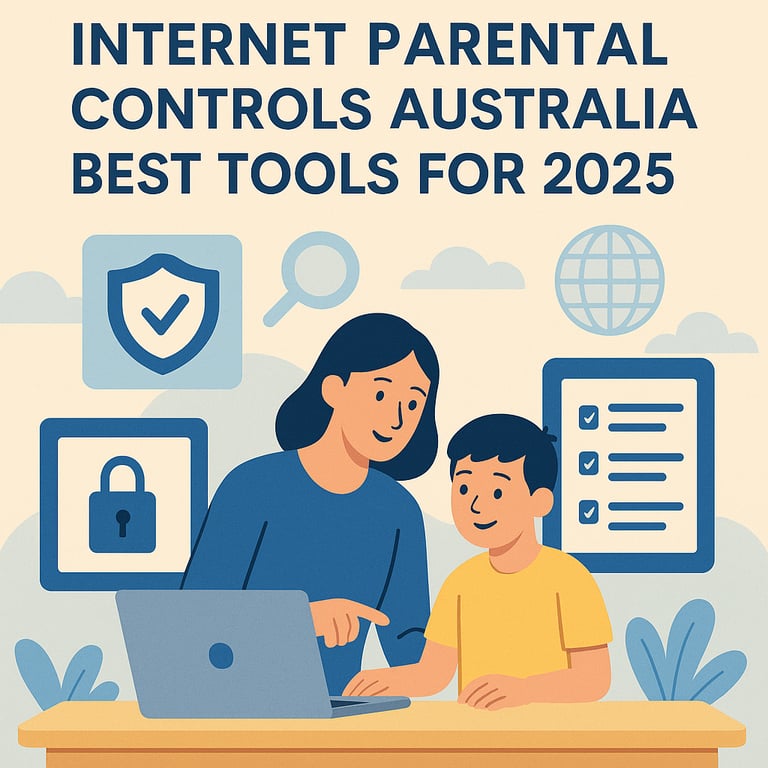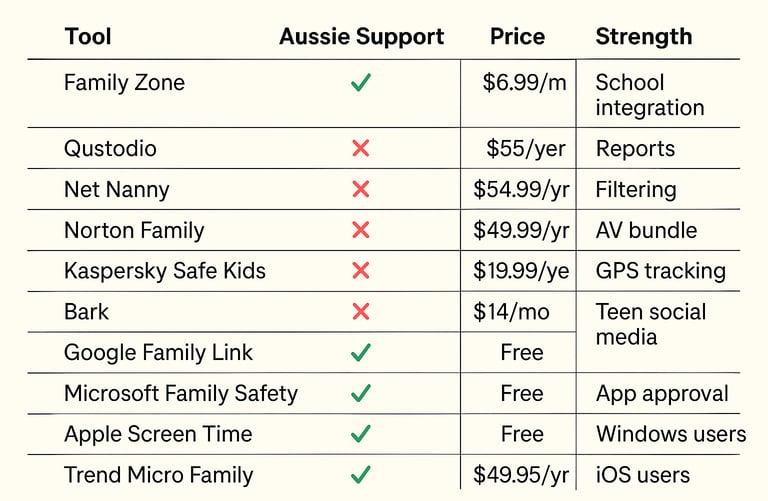Internet Parental Controls in Australia: Best Tools for 2025 (Full Guide)


Introduction – Why Every Australian Family Needs Parental Controls in 2025
In 2025, the internet is no longer a luxury for Australian children — it’s part of everyday life. Whether it’s watching Bluey on ABC iView, playing Roblox, chatting with friends on Messenger Kids, or doing school assignments on Google Classroom, children are online more than ever before.
While the internet offers incredible opportunities for learning and creativity, it also exposes kids to dangers:
Inappropriate or harmful content
Cyberbullying
Online predators
Phishing scams
Excessive screen time
The eSafety Commissioner’s 2024 Youth Report revealed that over 1 in 4 Australian children have seen harmful or age-inappropriate content online, and 21% have been contacted by strangers.
This is where parental control tools become essential. They help parents:
Block unsafe websites and apps
Set time limits on device use
Monitor online activity
Receive alerts about potential risks
If you’ve already read our article Online Safety for Kids: Parental Controls That Work, you’ll know that tools alone aren’t enough — they must be combined with education and open communication.
This guide will cover:
Why parental controls are so important in Australia in 2025
The top 10 tools for Aussie families
How to set them up on different devices and platforms
Extra strategies and government resources you can use
By the end, you’ll have a step-by-step action plan to protect your children online.
2. The State of Internet Safety for Kids in Australia
2.1 Digital Childhood Starts Early
94% of Australian children aged 6–13 use the internet daily.
70% of preschoolers regularly use tablets or smartphones.
The average age for a first smartphone is now just 10 years old.
Popular activities include YouTube, gaming (Roblox, Minecraft, Fortnite), TikTok, Snapchat, and streaming services like Netflix and Disney+.
2.2 Top Online Risks in 2025
Inappropriate Content – Adult imagery, violent videos, gambling ads, drug promotion.
Cyberbullying – 20% of Aussie kids report being bullied online.
Predators & Grooming – Contact through games, DMs, and chat rooms.
Scams – Fake prize notifications, gaming currency theft, phishing links.
Screen Addiction – Poor sleep, reduced school performance, anxiety.
📌 For examples of scams that could target kids, read our article: Top 10 Online Scams Targeting Australians in 2025.
2.3 Current Parental Approaches
Built-in controls like Apple Screen Time and Google Family Link.
Third-party apps like Family Zone or Qustodio.
Many still have inconsistent safety between devices, leaving gaps for risks.
3. What Are Parental Controls?
Parental controls are software or device settings that help manage a child’s online experience by:
Filtering websites and blocking harmful content
Setting screen time limits
Monitoring search history and app use
Restricting who can contact your child
Types of parental controls:
Device-based – Built into phones, tablets, gaming consoles.
App-based – Downloaded software like Qustodio or Net Nanny.
Network-based – Set up via your Wi-Fi router.
Browser-based – Safe search modes or extensions.
4. Best Parental Control Tools in Australia for 2025
Below is a detailed review of the top tools for Aussie parents, with features, pros & cons, prices, and local tips.
4.1 Family Zone (Australian-Made & School Integrated)
Website: familyzone.com
Why Aussies love it: Australian company, used in many schools.
Features:
Web filtering
Social media monitoring
Cyberbullying alerts
Time scheduling
Pros: School-home sync, great Aussie customer support.
Cons: Paid subscription.
Price: From $6.99/month.
💡 Tip: Check with your child’s school — many provide Family Zone for free.
4.2 Qustodio
Website: qustodio.com
Features:
App blocking
Location tracking
YouTube monitoring
SOS button
Pros: Detailed reports, easy to use.
Cons: Premium required for full features.
Price: From $55/year.
4.3 Net Nanny
Website: netnanny.com
Features:
Real-time content filtering
Pornography blocking
Social media alerts
Pros: Highly customisable filters.
Cons: Slightly complex setup.
Price: From $54.99/year.
4.4 Norton Family
Website: us.norton.com
Features:
Web supervision
Time limits
Search monitoring
Pros: Bundled with some Norton antivirus plans.
Cons: Limited Mac support.
Price: $49.99/year.
4.5 Kaspersky Safe Kids
Features:
GPS tracking
App control
YouTube search history
Pros: Affordable.
Cons: UI could be simpler.
Price: From $19.99/year.
4.6 Bark
Features:
AI-powered social media monitoring
Cyberbullying detection
Suicide/self-harm alerts
Pros: Ideal for teenagers.
Cons: Less useful for very young kids.
Price: From $14/month.
4.7 Google Family Link
Features:
App approval
Time limits
Location tracking
Pros: Free, works well for Android.
Cons: Limited filtering.
Price: Free.
4.8 Microsoft Family Safety
Features:
Screen time limits
Location sharing
Web filtering for Edge
Pros: Free with Microsoft accounts.
Cons: Best for Windows users.
Price: Free.
4.9 Apple Screen Time
Features:
App limits
Content restrictions
Downtime scheduling
Pros: Built-in to iOS/macOS.
Cons: Apple devices only.
Price: Free.
4.10 Trend Micro Family
Features:
Social media privacy scan
Web filtering
App control
Pros: Includes antivirus.
Cons: Best for tech-savvy parents.
Price: From $49.95/year.
Comparison Table
5. How to Choose the Right Parental Control
Factors to consider:
Age of your child – Younger kids need strict filtering, teens need monitoring.
Devices used – iOS, Android, Windows, gaming consoles.
Budget – Free options may suffice, but paid give more features.
Ease of use – Choose what you can manage consistently.
6. Step-by-Step Setup Guide
6.1 Apple Devices
Go to Settings → Screen Time
Tap Turn On Screen Time
Set passcode, configure downtime, app limits, content restrictions.
6.2 Android Devices
Download Google Family Link from Play Store.
Link child’s account, set filters, daily limits, and app approvals.
6.3 Routers
Log in to your router admin page (usually 192.168.0.1).
Find Parental Controls tab.
Set site filters and schedule internet downtime.
6.4 Streaming Platforms
YouTube Kids – Enable age filters.
Netflix – Create kid profiles with maturity rating limits.
Disney+ – Use kid mode.
📌 For extra safety tips, see Cyber Hygiene Checklist: Are You Doing These 7 Things?.
7. Beyond Parental Controls
Educate your child – Teach them to spot scams.
Set boundaries – Device-free dinners, bedtime cut-off.
Lead by example – Model healthy screen habits.
8. Government & School Resources
eSafety Commissioner – Guides, complaint handling.
ThinkUKnow Australia – Police-led education.
Cyber.gov.au – Cybersecurity advice.
Final Thoughts
Parental controls are a layer of defence, not a substitute for parenting. The best approach is combining technology, education, and open communication.


Safety
Empowering families to navigate online risks securely.
Community
“CyberShield Academy © 2025. All rights reserved.”